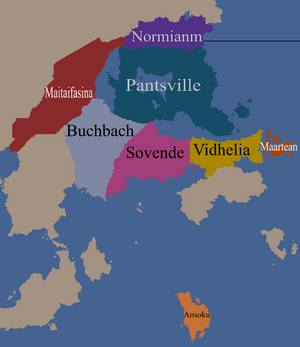Juznia (subcontinent)
This article is incomplete because it is pending further input from participants, or it is a work-in-progress by one author. Please comment on this article's talk page to share your input, comments and questions. Note: To contribute to this article, you may need to seek help from the author(s) of this page. |
 | |
| Area | 7,600,000 mi2 |
|---|---|
| Population | 131,000,000 |
| Population density | 17 |
| Religions | Mathetism, Kysondo, Elianism |
| Countries | Pantsville, Norminianm, Buchbach, Sovende, Maartean, Maitafasnia & Vidhelia |
| Languages | Hansan, Buchish |
Juznia is a continent located in the souther and eastern hemispheres. Juznia is bordered to the north nordaterra to the east by the aurean ocean, to the south by the albusian sea and to the west by western magnaterra. The continent was subjected to colonization and subsequent mass death due to disease and conflict. It was named by the Hansans, who had coined the term earlier, taken from slavic naming meaning "of the south."
History
Pre-colonial -1700
Colonial Era 1700-1850
The first contact between Amnis and Juznia would happen in the 1710s, when Hansan explorers navigated south beyond the coasts of Nordaterra. They ended up in what would become modern day NAME, and after stealing a bunch of goods and returning back to Hansa, they decided to fund a colony in the area, on march 28th the Hansans landed in the Province of Rutinia in modern day Pantsville, and established the colony of Wurgellia. After expanding and seeing good success in the Wurgellia colony, more settler from Hansa would arrive in the south of Juznia, creating Buchbach. Sometime in the coming decade, biggonia would establish a colony in south eastern juznia named Vidhelia. After Hansa struggled to control their colony in Buchbach, along with the buchish people wanting to have complete autonomy the colony quickly cutoff all ties with Hansa forming the Landgraviate of Buchbach, and integrated itself with Biggonia. By 1800 Buchbach had become an official duchy of biggonia. In Wurgellia significant land had been gained by 1800 and Pantsville was full of plantations and mines, with it exporting goods back to Hansa. In 1847 Buchbach had gained independence from biggonia due to a power struggle in the Biggonian homeland.